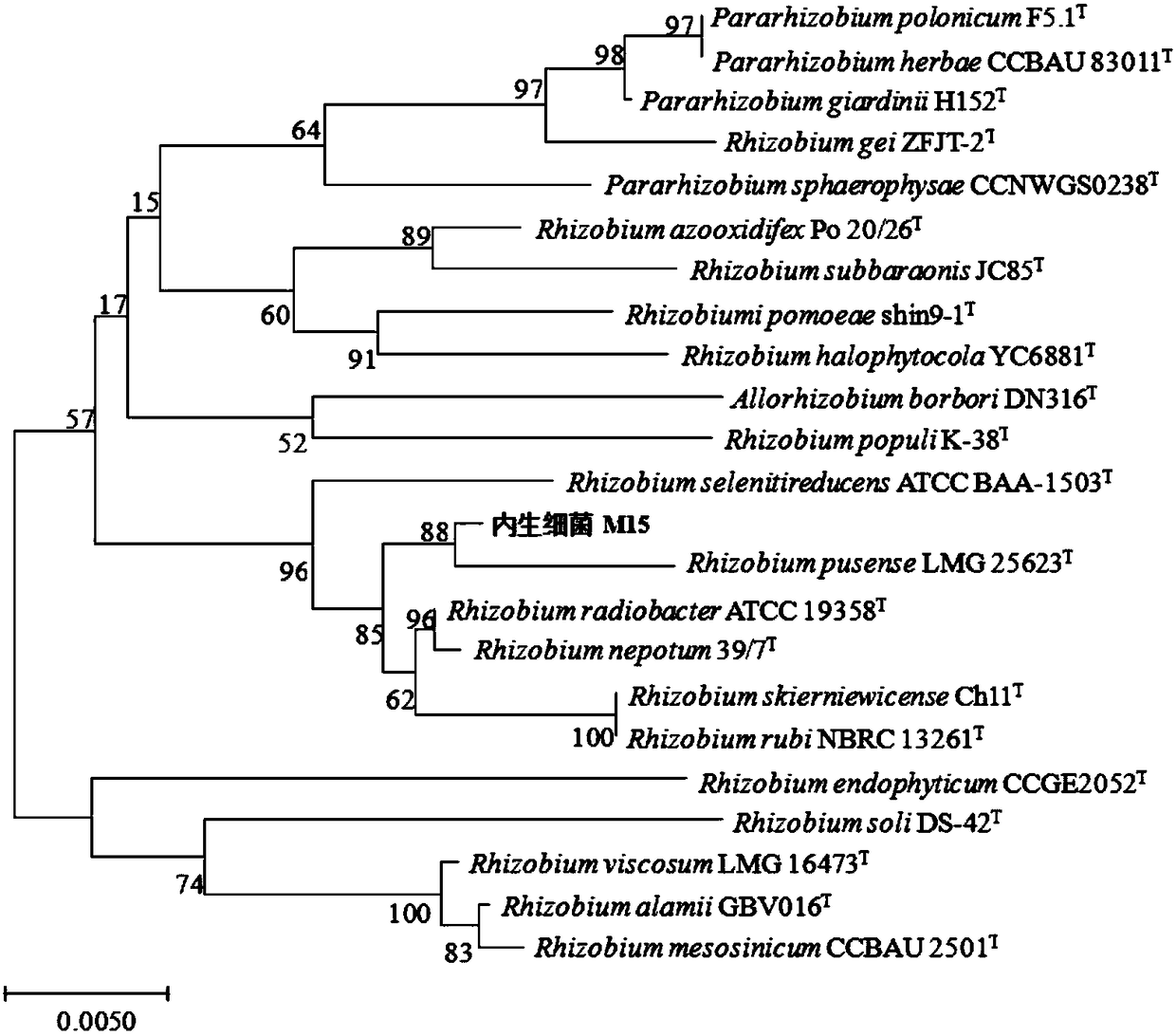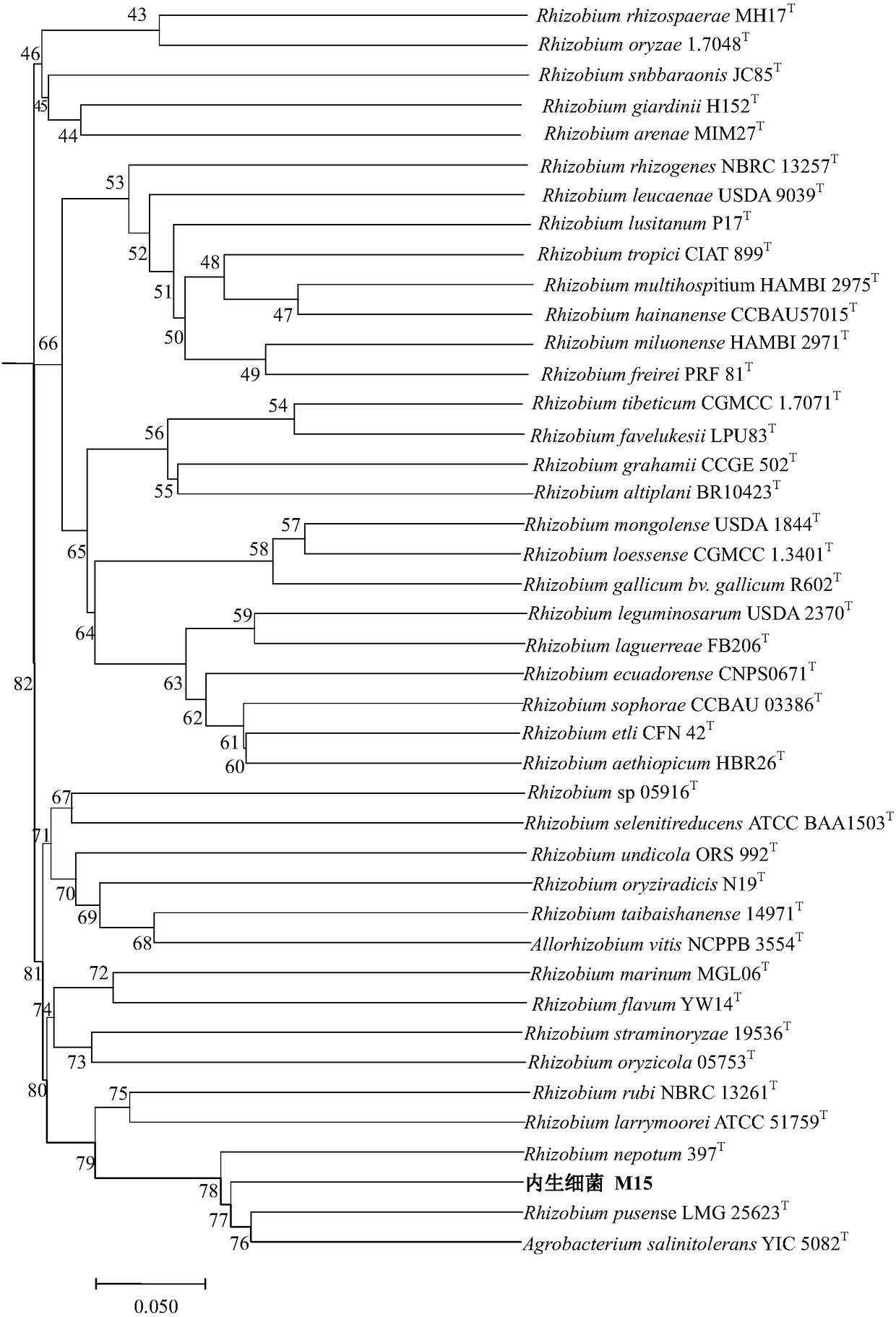Endogenous growth-promoting rhizobium of rices and application thereof
A rice rhizobium, microbial strain technology, applied in applications, bacteria, biocides, etc.
- Summary
- Abstract
- Description
- Claims
- Application Information
AI Technical Summary
Problems solved by technology
Method used
Image
Examples
Embodiment 1
[0050] Example 1. Isolation and identification of Rhizobium oryzihabitans M15
[0051] 1 Isolation of Rhizobium oryzihabitans M15
[0052] Rhizobium oryzihabitans M15 was isolated from rice roots, and the rice variety was 90-3 (Oryza sativa L.japonica 90-3). The sampling location was the 100-acre agricultural experiment demonstration base in Sangyuan Town, Luannan County, Hebei Province. Separation process: The rice root surface was sterilized by ethanol-sodium hypochlorite, and after gradient dilution, the R 2 A was isolated by coating on solid medium, cultured at 28°C for 48 hours, picked a single colony on the plate and streaked to purify to obtain a purified strain, and stored on the slanted surface in a refrigerator at 4°C. One of the isolated and purified endophytic bacteria was numbered M15, hereinafter referred to as endophytic bacteria M15.
[0053] Identification of Rhizobium oryzihabitans M15
[0054] 2.1 Morphological identification
[0055] Describe the colony...
Embodiment 2
[0075] Embodiment 2, the physiological and biochemical characteristics of rice rhizobium (Rhizobium oryzihabitans) M15
[0076] 1.1 Determination of salt tolerance: Inoculate the same concentration of Rhizobium oryzihabitans M15 bacterial liquid in YMA liquid medium containing 0%, 1.0%, 3.0%, 5.0%, 7.0%, 8.0%, 10.0% NaCl (1% inoculum size, v / v), shake culture at 30°C for 7 days, measure the absorbance value at 600nm with a UV-1800 ultraviolet spectrophotometer, and find that Rhizobium oryzihabitans M15 can still survive at a salinity of 7.0%. growth (weak growth), and the optimum growth salt concentration range is 0-3%.
[0077] 1.2 pH range measurement: prepare phosphate buffer solution (solution A: 8.3mL phosphoric acid, add deionized water, mix and set the volume to 500mL; solution B: Na 2 HPO 4 14.326g, add deionized water and mix to 500mL; take 72.5mL of A solution and 27.5mL of B solution and mix evenly, pH is about 2.0), acetic acid-sodium acetate buffer system (0.2m...
Embodiment 3
[0081] Example 3, Qualitative detection and quantitative analysis of auxin secreted by Rhizobium oryzihabitans M15
[0082]According to reference (Eric Glickm ann, Yves Dessaux.A critical examination of the specificity of the salkowski reagent for indolic compounds produced by phytopathogenic bacteria[J].Applied and Environmental mental Microbiology, 1995(2):793-796) described Salkowski colorimetry was used to determine the performance of auxin (IAA) secretion from Rhizobium oryzihabitans M15. Rhizobium oryzihabitans M15 was inoculated in R 2 A liquid culture medium was cultured on a shaker at 28° C. and shaken at 180 rpm for 4 days to obtain a fermentation broth of Rhizobium oryzihabitans M15. uninoculated R 2 A liquid medium is used as a blank control to measure the OD600nm value of the rice rhizobium (Rhizobium oryzihabitans) M15 fermentation liquid, and the result shows that the OD600nm value of this rice rhizobium (Rhizobium oryzihabitans) M15 fermentation liquid is 1.5...
PUM
 Login to View More
Login to View More Abstract
Description
Claims
Application Information
 Login to View More
Login to View More - R&D
- Intellectual Property
- Life Sciences
- Materials
- Tech Scout
- Unparalleled Data Quality
- Higher Quality Content
- 60% Fewer Hallucinations
Browse by: Latest US Patents, China's latest patents, Technical Efficacy Thesaurus, Application Domain, Technology Topic, Popular Technical Reports.
© 2025 PatSnap. All rights reserved.Legal|Privacy policy|Modern Slavery Act Transparency Statement|Sitemap|About US| Contact US: help@patsnap.com



